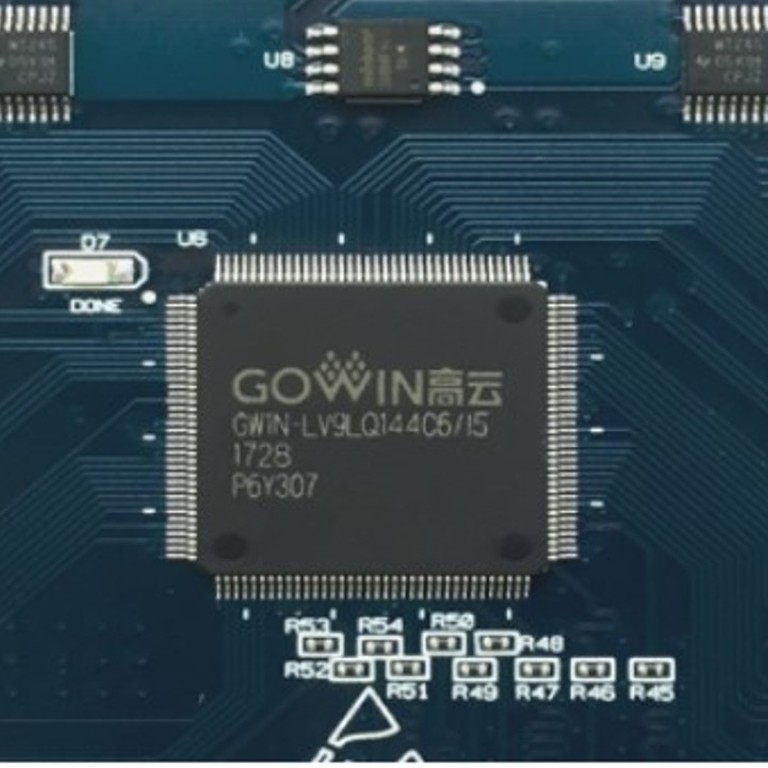
‘Made in China 2025’: the Guangzhou start-up aiming big in semiconductors
Gowin Semiconductor says it is seeing increased interest in its FPGA chips, a market dominated by US firms including Xilinx, Altera and Lattice
As China’s use of smart devices and artificial intelligence (AI) surges, a new generation of domestic chip makers is focusing on specialised semiconductors to power the technologies of tomorrow, as the country seeks to build a tech industry commensurate with its economic power.
Take Guangzhou-based Gowin Semiconductor. The four-year-old start-up, which makes field-programmable gate array (FPGA) chips, believes it has what it takes to challenge the global leaders, US companies Xilinx, Altera and Lattice, which together control 90 per cent of the global market for the special chips.
In the past few months, Gowin has begun mass production of its low- and mid-density FPGA chips, for which it holds full intellectual property rights. The chips – which can be configured after manufacturing, and are used in sectors including automotive, video interfaces, electronics, telecommunications, defence and aerospace – are made for the company by the world’s biggest contract manufacturer, Taiwan-based TSMC. They are currently for sale in the mainland Chinese market.
Gowin expects to sell 10 million FPGA chips this year. That would be a stark contrast to the company’s first order for just 10 chips in January 2017.
Its big break came after the crisis over Chinese telecoms equipment maker ZTE, which came close to being put out of business after Washington banned American firms from selling to ZTE because of its violation of US sanctions on Iran and North Korea.
Although the ban was lifted and ZTE survived with a fine of US$1.4 billion, the incident was a stark reminder to China of the pressing need to ramp up research and development of high-end semiconductors to reduce reliance on the West.
“ZTE paid for the costly consequences, but Chinese companies and authorities are now fully aware of the strategic importance of making high-end chips,” said Cyrus Liang, assistant to Gowin’s CEO.
The ban also triggered a shift in the long-held perception among Chinese users that foreign chips were better than domestically produced ones.
“Things have changed now. We have been hotly pursued by a growing number of domestic clients and investors,” Liang said.
Gowin – founded by engineers Zhu Jinghui and Ning Song, who had worked at Lattice – recently struck a deal with the Guangzhou Economic and Technological Development Zone, which will provide the company with financial support of up to 80 million yuan (US$11.7 million) in tax concessions and subsidies in the next two years.
It also said it was close to securing its first round of venture capital financing of at least 100 million yuan (US$14.6 million) from domestic investors.
According to the company, its existing 55-nanometre (nm) fabrication process means it is already able to compete with existing low- and mid-density FPGA chips made by its US rivals, and it will move to a higher end of their market next year when it launches a 28nm product. The smaller the size of the chip circuits, the more can be placed on a chip, thus increasing its power while retaining a small size.
Gowin said its ability to combine processing units into FPGA chips could expand their applications, and the market as a whole, into burgeoning tech industries such as robotics, drones, autonomous driving and 5G communications.
However, Gowin’s R&D relies on hardware architecture from Arm Holdings, a British chip design firm owned by Japan’s Softbank, and on circuit-design software from US company Synopsys. One of China’s aims with its tech push, embodied in the “Made in China 2025” industrial master plan, is to reduce such dependence.
“It’s still a fact that neither China nor any other countries’ chip development can bypass US tech intellectual property,” said Luo Jun, founder of the International Robotics and Intelligent Equipment Industry Alliance – a China-based agency facilitating cross-border research exchanges in cutting-edge technology.

